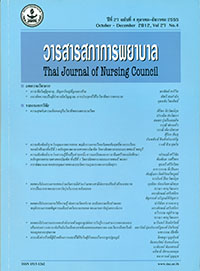การแจ้งข่าวร้ายที่ผู้ป่วยต้องการและที่ได้รับในผู้ป่วยมะเร็งกระดูกปฐมภูมิ
Keywords:
การแจ้งข่าวร้าย, ความต้องการ, ผู้ป่วยมะเร็งกระดูกปฐมภูมิ, diagnosis notification, patients’ needsAbstract
บทคัดย่อ
การแจ้งข่าวร้ายเรื่องการวินิจฉัยมะเร็งส่งผลต่อการเกิดปัญหาทางอารมณ์และ พฤติกรรม รวมถึงอาจเป็นอุปสรรคต่อแผนการรักษา การวิจัยนี้มีวัตถุประสงค์เพื่ออธิบาย การแจ้งข่าวร้ายจากแพทย์ที่ผู้ป่วยมะเร็งกระดูกปฐมภูมิต้องการและเปรียบ เทียบการแจ้ง ข่าวร้ายที่ผู้ป่วยเคยได้รับ กลุ่มตัวอย่างเป็นผู้ป่วยมะเร็งกระดูกปฐมภูมิจำนวน 96 คน เครื่องมือที่ใช้ในการเก็บรวบรวมข้อมูล คือ แบบสอบถามความต้องการการแจ้งข่าวร้าย และการแจ้งข่าวร้ายที่เคยได้รับจากแพทย์ การวิเคราะห์ข้อมูลใช้สถิติเชิงบรรยาย และ paired-T-test
ผลการวิจัยพบว่า ผู้ป่วยส่วนใหญ่ต้องการการแจ้งข่าวร้ายในหมวดข้อมูลมากกว่า หมวดการสนับสนุนและเอื้ออำนวยระหว่างการแจ้งข่าวร้าย ระดับคะแนนสูงสุดที่ผู้ป่วยต้องการ คือ ข้อมูลเกี่ยวกับการรักษาที่ดีที่สุด (ร้อยละ 59.4) ความมั่นใจในทักษะและความสามารถ ในการดูแลรักษา (ร้อยละ 50) การแสดงความสนใจ ห่วงใยจากแพทย์ (ร้อยละ 49) การได้รับข้อมูลที่มากเพียงพอ (ร้อยละ 45.8) และผู้ป่วยส่วนน้อยต้องการคำแนะนำจาก แพทย์ว่าจะบอกผู้อื่นอย่างไรเกี่ยวกับโรคมะเร็งที่เป็น (ร้อยละ 12.5) นอกจากนั้นยังพบ ว่าระดับคะแนนการแจ้งข่าวร้ายที่ผู้ป่วยได้รับนั้นน้อยกว่าที่ต้องการอย่าง มีนัยสำคัญทาง สถิติที่ระดับ p = 0.05 ข้อเสนอแนะ การแจ้งข่าวร้าย ควรให้ความสำคัญกับการให้ข้อมูลมากที่สุด และผู้ป่วยยัง ต้องการการสนับสนุนและเอื้ออำนวยจากแพทย์ระหว่างการแจ้งข่าวร้าย การเข้าใจความต้องการ ของผู้ป่วย จะช่วยให้บุคลากรทีมสุขภาพ ตระหนักถึงความสำคัญในการปรับเปลี่ยนรูปแบบ การแจ้งข่าวร้ายและให้การดูแลด้านจิตสังคมตามความต้องการของผู้ป่วย
คำสำคัญ : การแจ้งข่าวร้าย, ความต้องการ, ผู้ป่วยมะเร็งกระดูกปฐมภูมิ
Abstract
Cancer diagnosis notification often has emotional and behavioural effects on the patients and may interrupt their cancer treatment plans. This study, therefore, was conducted for the purposes of identifying methods of diagnosis notification preferred by primary-stage bone cancer patients and comparing the preferred methods with those previously used on the patients. The subjects were 96 primary-stage bone cancer patients from whom data were collected through a questionnaire which asked the subjects to identify their preferred and their received methods of diagnosis notification. The data were analysed using descriptive statistics and paired T-test.
The study revealed that most of the subjects preferred being informed of diagnostic facts to being given moral support and encouragement. The four highest-scored aspects of notification were ‘best medical treatment’ (59.4%), ‘confidence in physician’s medical skills and ability’ (50%), ‘physician’s attention and concern’ (49%) and ‘sufficient information’ (45.8%). On the other hand, only a small percentage of the subjects (12.5%) expected physicians’ advice on how to notify other patients of their diagnosed cancers. Besides, the subjects’ satisfaction with the received method of diagnosis notification was rated significantly lower than was their satisfaction with the preferred method, at p = 0.05.
Based on the findings, it is recommended that diagnostic facts be the top priority in the process of diagnosis notification and that physicians’ support and encouragement be still regarded as necessary in the notification process. Proper understanding of patients’ needs can enable healthcare personnel to realise the importance of adjusting diagnosis notification methods and providing patients with proper psycho-social care.
Keywords : diagnosis notification, patients’ needs








